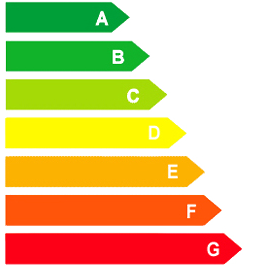
Energy certification of buildings
The energy certification of buildings tells us how efficient a building is in terms of energy consumption.
What is energy certification?
The energy performance certificate is the result of calculating the energy consumption necessary to satisfy the energy demand of the building under normal operating and occupancy conditions. Buildings are classified on a seven-letter scale, where G is the least efficient building and A is the most efficient one in terms of energy consumption and CO2 emissions, as compared to a base building of similar type and location.
How is the energy certification scale interpreted?
A professional energy performance certification can only be issued by a qualified professional who can guarantee its validity.

Within this scale, the values from D to E, in yellow and orange, are the most common and serve as reference values. For example, they are used when averaging the consumption of a building’s utilities. Therefore, if a building obtains a D or E rating, it passes within the established sustainable building rating.
Meanwhile, the F and G values marked in red mean that the building has a higher than average expenditure and is not very or not at all efficient.
Conversely, A, B and V values mean that the building is extremely efficient and compliant with the sustainability criteria used for the measurement, which is a plus when it comes to savings.
This rating is based on the assessment of the building, regardless of its actual use, simulating homogeneous operating conditions for all cases, so that buildings can be identified and compared by their energy quality and not by the use made by their occupants, an essential consideration to help in the decision to buy, rent or renovate a building.
How is an Energy Certificate obtained?
To obtain an energy efficiency certificate, a qualified technician must be contacted, who will take a series of data to carry out the certification and register it with the competent body in the autonomous community.
Who carries out the energy certification?
RD 390/2021 of 1 June establishes who carries out the energy certification:
- Architects
- Technical architects
- Engineers
- Technical engineers
Energy certification procedure
The technician will make at least one visit to the property to collect the necessary data and perform tests and checks in order to generate a correct energy certification. This visit shall take place no more than three months before the certificate is issued. Building data, installation data (heating, hot water and air conditioning) and measurements of the building are necessary to draw up the energy performance certificate.
These data are divided into two groups:
- The building envelope: refers to how the building is constructed, e.g. the composition of walls and openings, doors, windows, etc.
- Installations: this group covers heating, cooling, hot water and, in the case of tertiary buildings, lighting installations.
How can energy efficiency be improved?
At AreaZero 2.0 we offer several tips that will help you to improve your energy efficiency:
- Replace traditional bulbs with new LED bulbs. If you have old appliances, replace them with new energy-efficient ones.
- Insulate windows, either by installing double glazed windows or by replacing them with new PVC or aluminium windows with a thermal break and double glazing.
- Implement appropriate decoration for energy optimisation, such as painting the walls in light colours.
What does the energy performance certificate contain?
The content of the mandatory energy performance certificate will need to include at least the following items:
- Identification of the building or part of the building requiring certification
- Identification of the procedure chosen to obtain the energy efficiency rating. This must include:
- A description of the energy characteristics of the building: thermal insulation, number of occupants, operations under normal conditions and energy-saving installations.
- Identification of the applicable energy saving and efficiency regulations at the time of construction.
- Full details of the tests, inspections and checks carried out by the certifying technician during the energy rating procedure.
- Energy rating. This is shown graphically by means of the colour-coded label.
- Document with recommendations by the technician, according to the technical and economic viability, as well as the energy impact they would have.
Without the mandatory energy certificate, the notary will not be able to complete the paperwork for the sale or rental of the property. The aim of this certification is to help buyers, but it can also be beneficial for the owner: a building with a higher energy performance certification will be easier to sell or rent.




